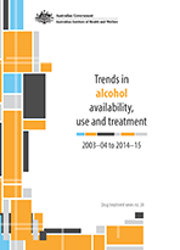Drinking alcohol is widely accepted in Australia. However, it is also understood that excessive alcohol use presents many risks of short- and long-term harm to the drinker and those around them.
In 2011 alcohol dependence was responsible for 1.5% of the total burden of disease in Australia, and alcohol was the third highest risk factor for disease (AIHW 2016b). While some positive patterns in drinking have emerged in recent years, alcohol has consistently accounted for the largest proportion of treatment episodes for people receiving specialist alcohol and other drug treatment services over time.
Nationally, the population rate of pure alcohol available for consumption has steadily declined since 2008–09 – although mixed trends were apparent by jurisdiction.
The total volume of pure alcohol available for consumption in Australia has increased from around 160 million litres of pure alcohol in 2004–05 to over 180 million litres in 2013–14. Once population growth was accounted for, apparent per capita consumption decreased from 10.8 litres per person in 2008-09 to 9.7 in 2013–14 – this trend varied by jurisdiction.
Research shows increasing the price of alcohol, restricting trading hours and reducing outlet density can have positive outcomes in reducing consumption and harms related to alcohol use.
Reviews into the effectiveness of different strategies to reduce alcohol consumption and the negative consequences of drinking alcohol have found strong evidence for the effectiveness of restrictions on economic availability (such as increased taxes and minimum pricing) and physical availability (such as restricting the days and hours of sale).
Across the Australian population the rate of alcohol use has decreased across several measures from 2004 to 2013 and the rate of treatment for alcohol has increased.
The biggest decreases in rates were reported for Australians drinking at risky levels on a single occasion (11%) and over a lifetime (13%). From 2003–04 to 2013–14, the rate of service usage for clients receiving alcohol treatment has increased by 20%, from 25 treatment episodes per 10,000 people to 30 episodes per 10,000 people.
Remote and very remote areas had higher rates than other areas for people drinking at risky levels and receiving treatment for alcohol in 2013; this was consistent over time.
Rates for those living in Remote and very remote areas increased across several measures of risk from 2004 to 2013, including single occasion risk; lifetime risk and monthly drinking at very high levels. Rates of alcohol treatment also increased for this group, from 13 episodes per 1,000 in 2007–08 to 16 in 2013–14.
Australians aged 18 to 24 were more likely than any other age group to drink at risky levels, but clients receiving treatment for alcohol were more likely to be aged over 40.
In 2013, most Australians who reported single occasion risky drinking (47%), yearly drinking at very high levels (33%) and monthly drinking at very high levels (18%) were aged 18 to 24. Those who reported lifetime risky drinking were most likely to be aged 40–49 (23%); similarly, the largest group of clients in treatment for alcohol were aged 40–49 (49%).



